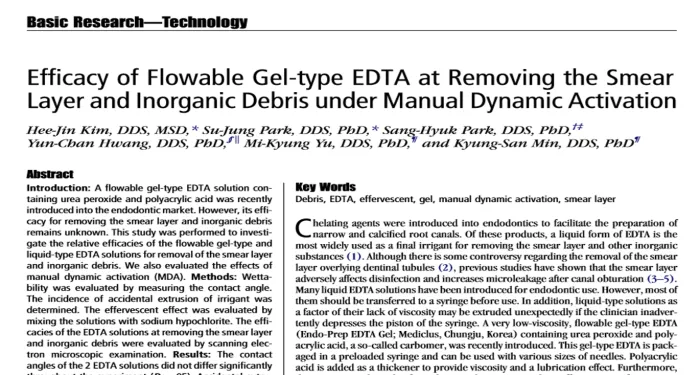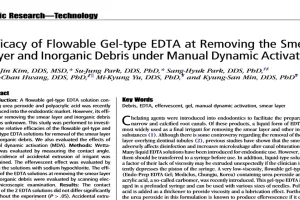

Efficacy of Flowable Gel-type EDTA at Removing the Smear Layer and Inorganic Debris under Manual Dynamic Activation
Abstract,
Introduction: A flowable gel-type EDTA solution containing urea peroxide and polyacrylic acid was recently introduced into the endodontic market. However, its efficacy for removing the smear layer and inorganic debris remains unknown. This study was performed to investigate the relative efficacies of the flowable gel-type and liquid-type EDTA solutions for removal of the smear layer and inorganic debris. We also evaluated the effects of Manual Dynamic Activation (MDA). Methods: Wetta-bility was evaluated by measuring the contact angle. The incidence of accidental extrusion of irrigant was determined. The effervescent effect was evaluated by mixing the solutions with sodium hypochlorite. The efficacies of the EDTA solutions at removing the smear layer and inorganic debris were evaluated by scanning electron microscopic examination. Results: The contact angles of the 2 EDTA solutions did not differ significantly throughout the experiment (P > .05). Accidental extrusion occurred 4 times for the liquid-type EDTA but never for the gel-type EDTA. The gel-type but not the liquid-type EDTA showed an effervescent effect. The EDTA/ MDA treatment combinations did not produce significantly different smear layer scores (P > .05). However, the debris scores for the coronal and middle parts were significantly lower for the gel-type EDTA with MDA than for the liquid-type EDTA without MDA (P < .05). Conclusions : Our results suggest that the newly introduced gel-type EDTA might be an acceptable irrigant for removing the smear layer and inorganic debris present on the root canal wall. (J Endod 2013;39:910– 914) Key Words, Debris, EDTA, effervescent, gel, manual dynamic activation, smear layer Chelating agents were introduced into endodontics to facilitate the preparation of narrow and calcified root canals. Of these products, a liquid form of EDTA is the most widely used as a final irrigant for removing the smear layer and other inorganic substances (1). Although there is some controversy regarding the removal of the smear layer overlying dentinal tubules (2), previous studies have shown that the smear layer adversely affects disinfection and increases microleakage after canal obturation (3–5). Many liquid EDTA solutions have been introduced for endodontic use. However, most of them should be transferred to a syringe before use. In addition, liquid-type solutions as a factor of their lack of viscosity may be extruded unexpectedly if the clinician inadver-tently depresses the piston of the syringe. A very low-viscosity, flowable gel-type EDTA (Endo-Prep EDTA Gel; Mediclus, Chungju, Korea) containing urea peroxide and poly-acrylic acid, a so-called carbomer, was recently introduced. This gel-type EDTA is pack-aged in a preloaded syringe and can be used with various sizes of needles. Polyacrylic acid is added as a thickener to provide viscosity and a lubrication effect. Furthermore, the urea peroxide in this formulation is known to produce effervescence if it contacts sodium hypochlorite (NaOCl) (6). The effervescent reaction can push debris out of the root canal through the path of least resistance into the chamber (7). However, more viscous EDTA solutions may fail to reach the apical area of the root canal when used as irrigants. Therefore, most viscous chelators are used predominantly to aid the nego-tiation of calcified canals or decrease frictional stress during root canal preparation using rotary instruments, and the viscosity of any solution to be used as an irrigant for smear layer removal should be regulated carefully. However, there has been no study showing the efficacy of the flowable gel-type EDTA at removing the smear layer and inorganic debris. An irrigant must directly contact the canal walls in order to be effective. However, it is often difficult to ensure that the irrigant reaches the apical portion of the canal because of the so-called vapor lock effect (8, 9). Research has shown that gently moving a well-fitting gutta-percha master cone up and down in short 2- to 3-mm strokes (manual dynamic activation [MDA]) within an instru-mented canal can produce an effective hydrodynamic effect and significantly improve the displacement and exchange of any desired reagent (10, 11). Although MDA has been advocated as a method for canal irrigation because of its simplicity and cost-effectiveness, there is little information about its effects on the smear layer and inor-ganic debris when used with the gel-type EDTA. This study aimed to investigate the efficacy of the newly developed flowable gel-type EDTA versus that of the conven-tional 17% liquid-type EDTA solution at removing the smear layer and inorganic debris. We further explored whether MDA could improve the efficacy of smear layer and debris removal.
For complete basic research, Instruction: please klik the link below and put it in browser. Don't forget to download! [color=#e75e32]EDTA GEL DOWNLOAD[/color]
 Efficacy of Flowable Gel-type EDTA at Removing the Smear Layer and Inorganic Debris under Manual Dynamic Activation
Efficacy of Flowable Gel-type EDTA at Removing the Smear Layer and Inorganic Debris under Manual Dynamic Activation

